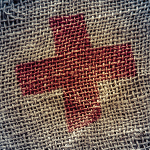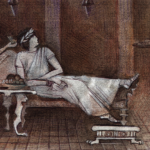Lee remained ill through the end of the war. He was diagnosed with heart disease, and during his remaining years, was plagued by “bouts of rheumatism.” One evening, while saying grace before dinner, he became aphasic, collapsed and died suddenly, presumably due to a fatal embolus launched from a heart valve damaged by rheumatic fever.
In the Trenches
Despite the heightened frequency of reactive arthritis among troops, the entity was not formally described until WWI. Contrary to popular belief, it was not the disgraced war criminal Hans Reiter, MD, who first reported this syndrome. Instead, we should bestow the honor on two French clinicians, Noel Fiessinger, MD, and Emile Leroy, MD, who described an “oculo-urethral-synovial” syndrome that occasionally developed post dysentery.6 In contrast, Reiter’s description, published several weeks following the French report, was rather brief. A mere two pages, it described a single case of urethral and joint symptoms in an army officer who subsequently developed ocular complaints.7 Most troublesome, however, was Reiter’s erroneous attribution of this illness to a spirochete infection. Until his death in 1969 at the age of 88, Reiter went to great lengths to promote his name and its use to designate the combination of urethral, joint and ocular symptoms.8
The brutality of warfare provided ample opportunity for clinicians to correlate the many traumatic peripheral nerve injuries with specific clinical disorders. These studies were pioneered during the Civil War by the Philadelphia physician, Silas Weir Mitchell, MD. He described the first cases of what he referred to as causalgia and what is now better known as complex regional pain syndrome. During WWI, enormous strides were made in understanding the function of the peripheral nervous system, led by neurologists whose names we recognize: the German, Paul Hoffman, MD, and the Frenchman, Jules Tinel, MD.
Not all neurologic insights were gained through the study of war injuries. Two other French clinicians, Georges Guillain, MD, and Jean-Alexandre Barré, MD, described a few unusual cases of paresthesias, progressive weakness and gait difficulties in French soldiers who had been admitted to a military hospital.9 They accurately distinguished this condition from the more common form of paralysis during that era, poliomyelitis, and believed that it carried a highly favorable prognosis. Curiously, a short time later, the eminent American neurosurgeon, Harvey Cushing, MD, who served with the American Expeditionary Force in France, was briefly stricken with Guillain-Barré syndrome himself. Cushing observed:9
Something has happened to my hind legs and I wobble like a tabetic and can’t feel the floor when I unsteadily get up in the morning.



